Economic Transformations and Social Changes in Trade
Topic 4.5 Reading Check Notes
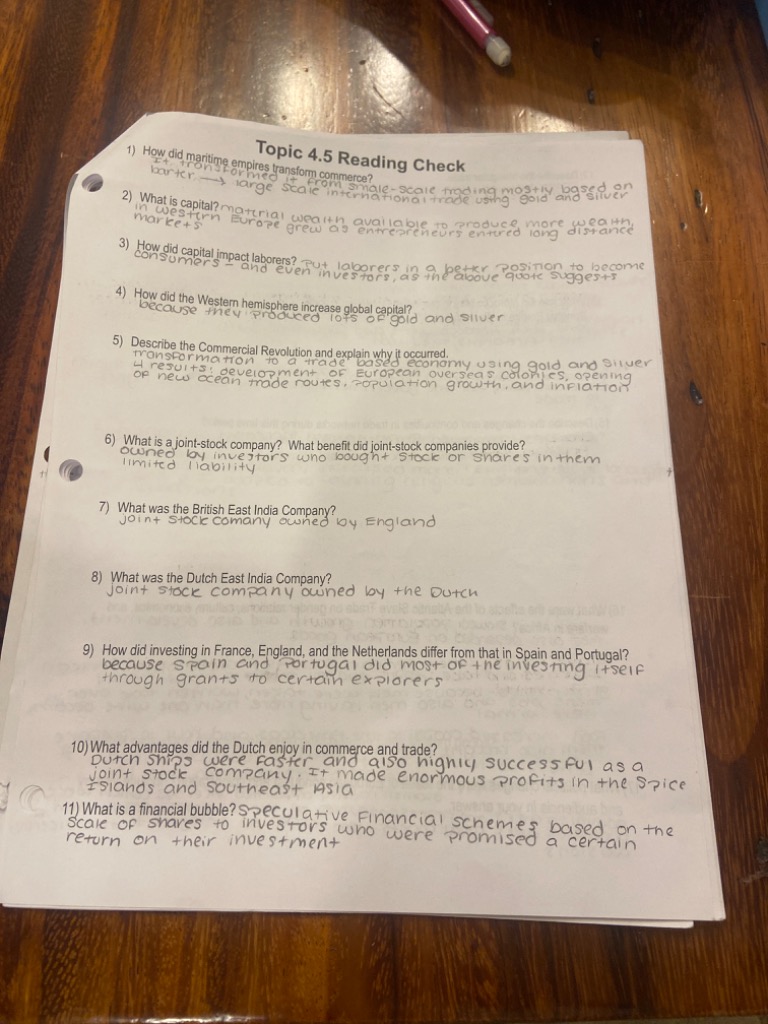
-
Maritime Empires Transforming Commerce
- Maritime empires shifted from small-scale trade to large-scale international trade, emphasizing exchanges involving gold and silver. This transformation likely enabled more extensive connections and economic growth, fostering a global trade network.
-
Capital
- Capital is defined as material wealth, indicating the importance of physical assets in economic exchanges. The accumulation of capital through trade and entrepreneurship was crucial during this period, leading to increased investments in new ventures.
-
Impact of Capitalist Laborers
- The role of capitalists empowered workers, allowing them to become consumers and investors. This shift likely contributed to social mobility and the emergence of a more prosperous middle class.
-
Global Capital Increase in the Western Hemisphere
- The Western hemisphere contributed to global capital primarily through the production of gold and silver, making significant economic contributions to international markets.
-
Commercial Revolution
- The Commercial Revolution marked a transition to a trade-based economy fueled by the influx of gold and silver. This resulted in new trade routes, expansion of overseas colonies, and overall economic growth and inflation.
-
Joint-stock Company
- A joint-stock company allows for pooled investments where investors buy shares. This system mitigates individual risk and promotes collective funding for ventures, enabling large-scale enterprise initiatives.
-
Dutch East India Company
- The Dutch East India Company was a joint-stock company owned by the Dutch, integral in maritime trade and exploration, particularly in the East Indies.
-
Investment Differences in European Nations
- Investment strategies in France, England, and the Netherlands differed from Spain and Portugal primarily because Spain and Portugal relied on the sovereign state to fund exploration through grants, which was less collaborative than the joint-stock model.
-
Advantages of the Dutch in Trade
- The Dutch benefited from having faster ships and a successful joint-stock company, leading to enormous profits, particularly in the lucrative Spice Islands and Southeast Asia.
-
Financial Bubble
- A financial bubble refers to speculative financial schemes where investors, attracted by the promise of high returns, buy shares. Such bubbles often lead to economic instability when the promise fails to materialize.
Extended readings:
Notes on Economic and Social Developments in Trade and Colonization
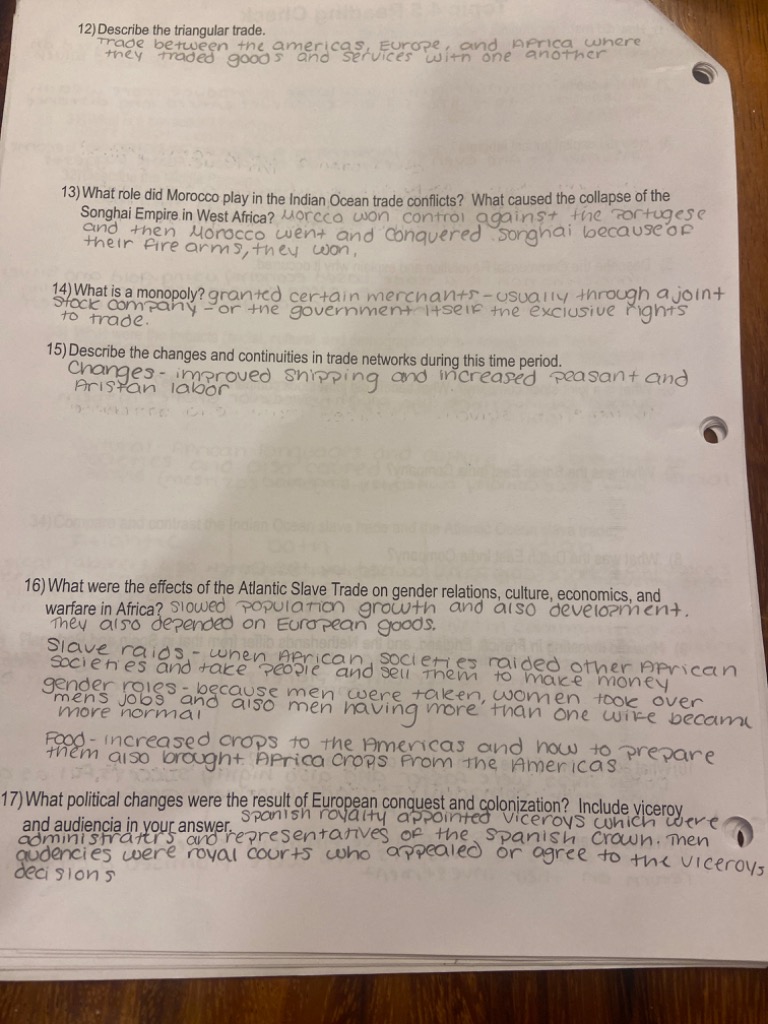
Triangular Trade
- Description: The triangular trade involved trade routes between the Americas, Europe, and Africa. Goods and services were exchanged, creating a complex economic network.
- Thoughts: This trade not only facilitated the movement of goods but also influenced social structures and economies across continents. It marked the beginning of global trade connections.
Morocco and the Indian Ocean Trade
- Role in Conflicts: Morocco gained control over trade routes in the Indian Ocean, contributing to the collapse of the Songhai Empire in West Africa. Their military strength was a key factor in their conquest.
- Thoughts: The power dynamics in the region shifted dramatically due to Morocco's assertiveness, showcasing how trade routes can influence political power.
Monopoly Definition
- Definition: A monopoly is when specific merchants, often via joint-stock companies, are granted exclusive rights by the government to control trade in a particular area.
- Thoughts: Monopolies can stifle competition and lead to exploitation of resources, highlighting economic disparities.
Changes in Trade Networks
- Notable Changes:
- Improved shipping technology.
- Increased peasant and artisan labor.
- Thoughts: Advancements in shipping allowed for faster and more efficient trade, while increased labor contributed to economic expansion. This also reflects shifting labor dynamics in society.
Effects of the Atlantic Slave Trade
- Impact on Gender Relations and Society:
- Slave raids destabilized African societies, leading to reduced population growth and altered gender roles.
- Men were often captured, causing women to take on roles traditionally held by men.
- Thoughts: This created a significant social restructuring within African communities and had long-term effects on family dynamics and societal structure.
Political Changes from European Conquest
- Changes due to Colonization: The Spanish crown appointed viceroys, who acted as representatives of royal authority in the colonies. These viceroys held significant power and were often appealed to by local courts.
- Thoughts: This centralized control allowed Spain to maintain authority over its vast empire and influenced colonial governance structures.
Summary of Additional Insights
- The interconnection between trade and conquest not only shaped economic landscapes but also led to profound social and political changes. The legacies of these developments continue to influence modern global relations and economies.
Extended readings:
Notas sobre la Conquista y Colonización Europea
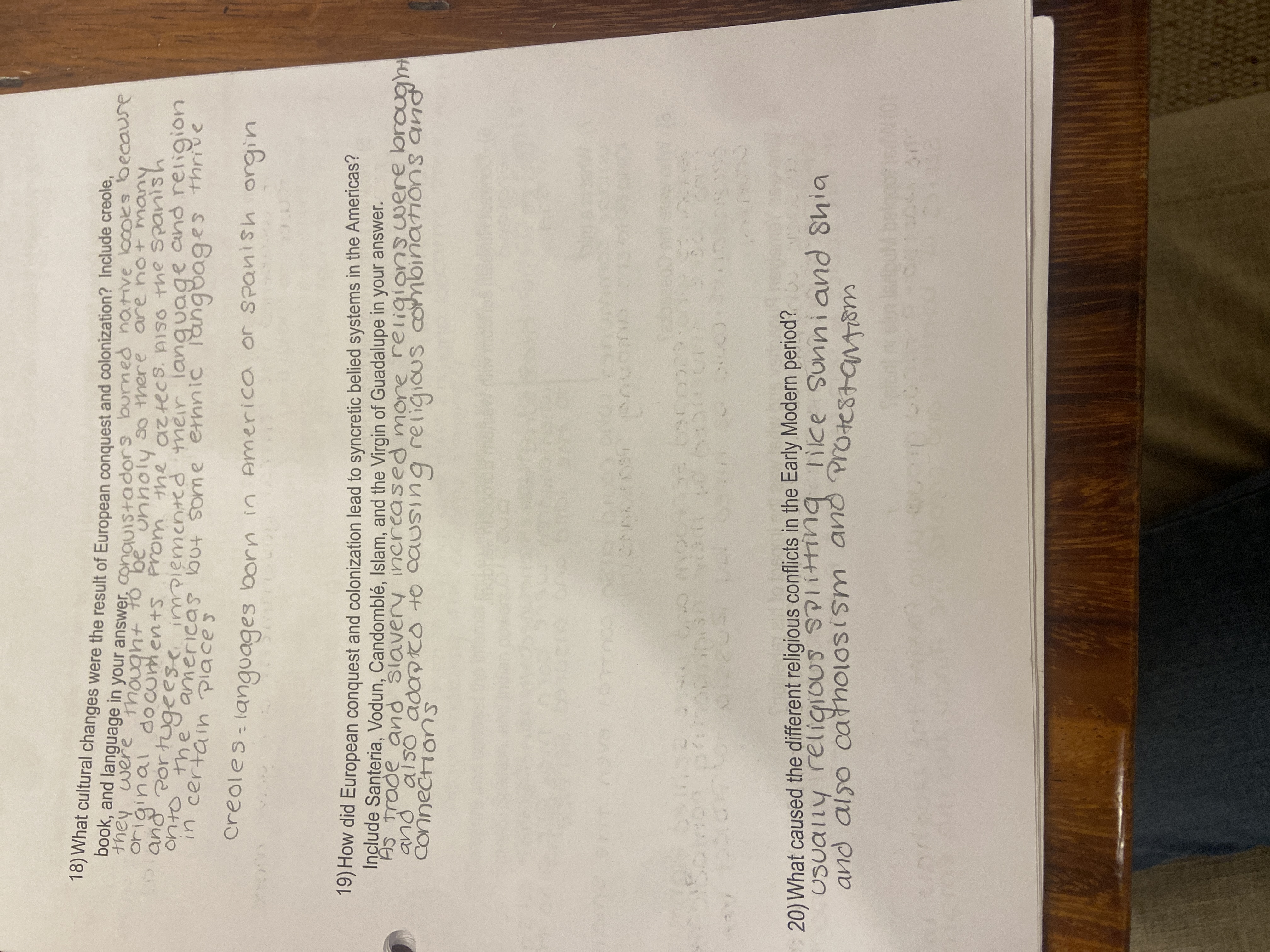
Cambios Culturales Resultantes de la Conquista
- Lenguas Criollas: Estas son lenguas que se formaron en las Américas a partir de la mezcla de lenguas indígenas y las traídas por colonizadores europeos, principalmente el español y el portugués.
- Importancia: La formación de lenguas criollas refleja la identidad cultural emergente en el contexto de colonización, donde tradiciones y lenguas nativas se adaptaron a influencias europeas.
Sincretismo Religioso en las Américas
- Religiones Sincréticas: La conquista condujo a combinaciones de creencias religiosas, como la Santería, el Vodún y el Candomblé, que resultaron de la fusión de tradiciones africanas e indígenas con el cristianismo europeo.
- Ejemplo de la Virgen de Guadalupe: Representa un punto de convergencia entre el catolicismo y las tradiciones indígenas, simbolizando la adaptabilidad y resistencia de las creencias nativas frente a la colonización.
- Influencia del Comercio y la Esclavitud: La expansión del comercio y el aumento de la esclavitud facilitaron la llegada de diversas religiones, creando un entorno propicio para el sincretismo.
Conflictos Religiosos en el Periodo Moderno Temprano
- Divisiones Religiosas: Los conflictos estaban frecuentemente relacionados con divisiones como el cisma entre sunitas y chiítas en el Islam, y las diferencias entre católicos y protestantes en el cristianismo.
- Contexto Histórico: Estos conflictos no solo reflejan tensiones religiosas, sino también luchas de poder político y social, y la influencia de la Reforma Protestante en Europa que cambió el mapa religioso del continente.
Estos aspectos demuestran cómo la conquista y colonización europeas provocaron profundos cambios culturales y religiosos, que aún influencian dinámicas sociales y culturales en las Américas.
Extended readings:
Topic 4.6 Reading Check Notes
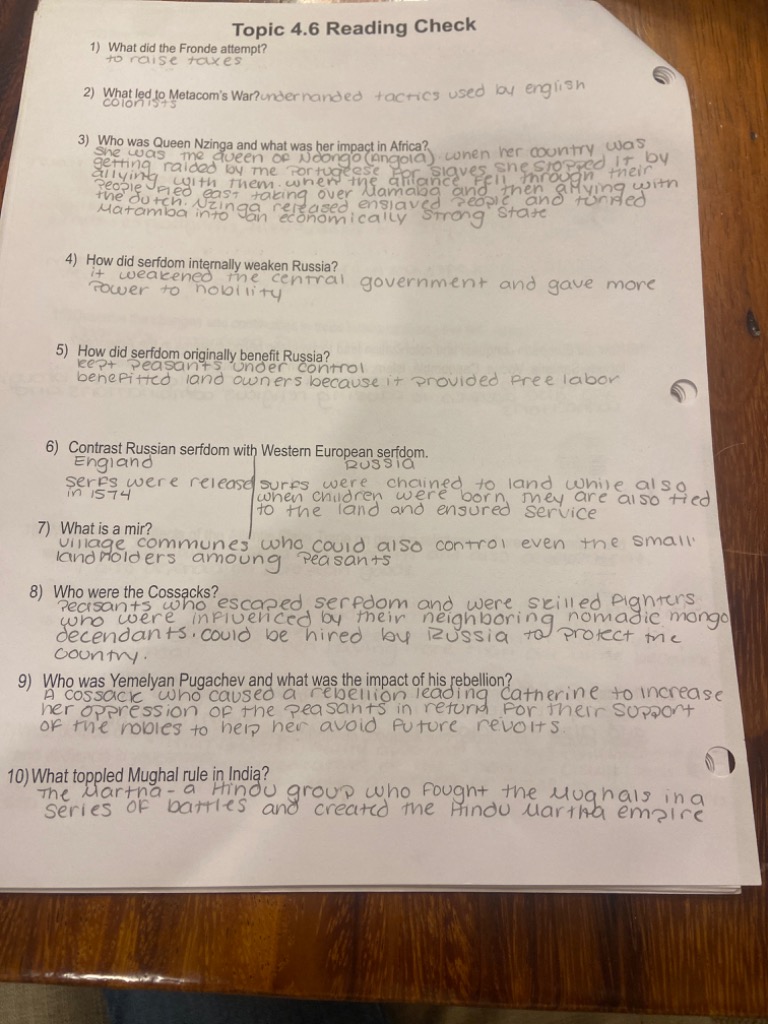
-
What did the Fronde attempt?
- The Fronde aimed to raise taxes against the monarchy's increasing fiscal demands. This reflects tensions between the French nobility and royal authority, highlighting the persistent struggle for power in France.
-
What led to Metacom's War?
- Metacom's War was characterized by underhanded tactics used by English colonists who exploited existing tribal tensions and conflicts. This conflict exemplifies the violent resistance of Native Americans to colonial expansion and the struggle for land and sovereignty.
-
Who was Queen Nzinga and what was her impact in Africa?
- Queen Nzinga was the queen of Ndongo (Angola) , who challenged Portuguese slave raids by strategically allying with other tribes. Her leadership is significant for its resistance to colonial powers, as she sought to enhance her nation's strength and maintain independence.
-
How did serfdom internally weaken Russia?
- Serfdom weakened the central government by transferring power to the nobility. This created a class of landowners wielding significant influence, undermining state authority and contributing to social stratification.
-
How did serfdom originally benefit Russia?
- Serfdom allowed the noble class to keep peasants under control and ensured a stable labor force for agriculture. This system provided free labor for landowners, facilitating economic productivity in a largely agrarian society.
-
Contrast Russian serfdom with Western European serfdom.
- England vs. Russia:
- In England, serfs could be released or gain freedom under certain conditions, while in Russia, serfs were often chained to the land and controlled more rigidly without the possibility of freedom.
- England vs. Russia:
-
What is a mir?
- A mir was a village commune in Russia that managed agricultural responsibilities and could exert control over its members, reflecting the communal structure of rural society and providing a form of local governance.
-
Who were the Cossacks?
- Cossacks were peasants who escaped serfdom and served as skilled fighters. Their interactions with nomadic tribes influenced their military practices, and they became integral to the Russian military, serving as a buffer against invasions.
-
Who was Yemelyan Pugachev and what was the impact of his rebellion?
- Pugachev led a rebellion that prompted Catherine the Great to increase oppressive measures against peasants. This rebellion highlighted the underlying discontent with the social hierarchy and the consequences for the ruling class in maintaining order.
-
What toppled Mughal rule in India?
- The Maratha, a Hindu group, rose against the Mughals, instigating a series of battles that ultimately led to the establishment of the Maratha Empire. This shift reflects the complex interplay of religious identities and political power in India's history.
Extended readings:
Notes on Colonial Struggles and Revolts
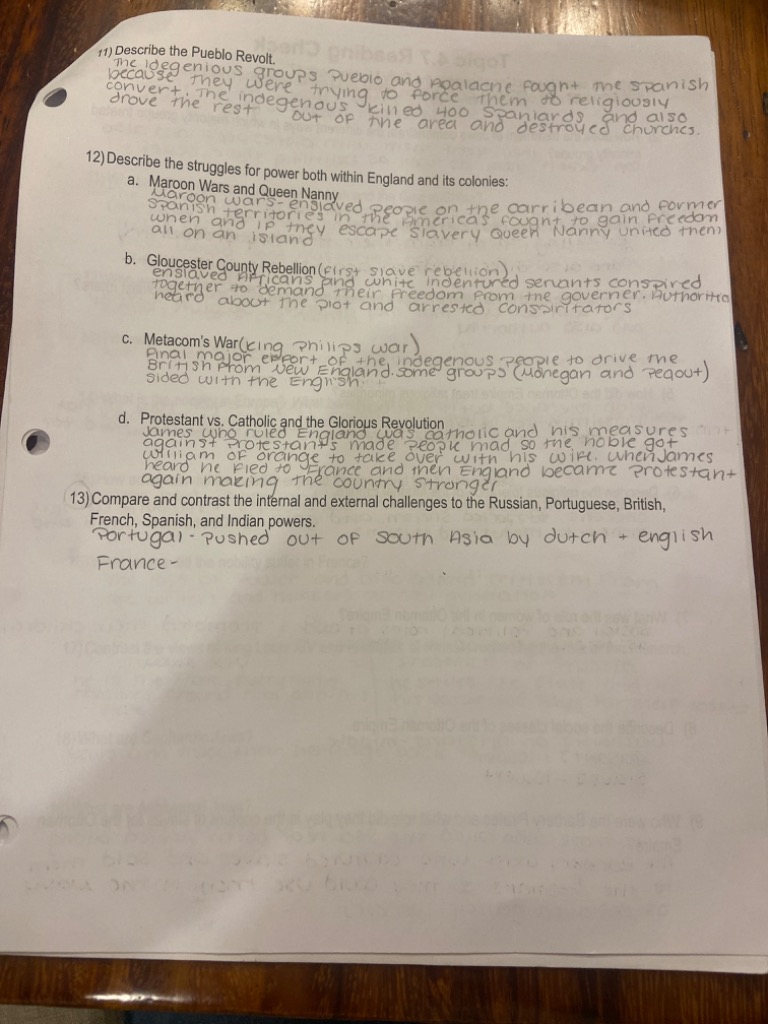
Pueblo Revolt
- Indigenous groups Pueblo and Palaú have resisted Spanish colonization.
- Tensions arose as they attempted to incorporate indigenous beliefs into their practices.
- The revolt led to the deaths of approximately 400 Spaniards and the destruction of missions.
- Thoughts: This highlights the clash between indigenous cultures and European colonial efforts, showcasing resistance to oppression.
Struggles for Power in England's Colonies
a. Maroon Wars and Queen Nanny
- Enslaved people in the Caribbean, particularly in Jamaica, protested against their oppression.
- Queen Nanny became a symbol of resistance, leading enslaved individuals in their fight for freedom.
- Ideas: These wars signal the struggle against colonial authority and the quest for autonomy in the Caribbean.
b. Gloucester County Rebellion
- Noted as one of the first slave rebellions in 1663.
- Enslaved individuals and indentured servants plotted to gain their freedom from colonial authorities.
- The rebellion emphasized the connection between different oppressed groups striving for freedom.
- Additional Info: This rebellion underscores early attempts at cooperation among marginalized groups.
c. Metacom's War (King Philip's War)
- Aimed to expel English settlers from New England.
- Metacom (King Philip) united various Indigenous tribes against colonial settlers.
- It was marked by violent confrontations and significant loss of life on both sides.
- Context: This illustrates the desperation of Indigenous leaders to maintain their land and sovereignty against colonial expansion.
d. Protestant vs. Catholic and the Glorious Revolution
- James II's Catholic rule faced opposition leading to the Glorious Revolution.
- Protestants and their parliamentary allies worked to prevent Catholic dominance.
- Note: This period reflects the broader context of religious tensions and the political maneuvering surrounding colonial governance.
Internal and External Challenges
- Comparison of various powers: Russian, Portuguese, British, French, Spanish, and Indian.
- Portugal was pushed out of South Asia by Dutch and English interests, which reflects the shifting colonial powers.
- Insights: Examining these dynamics shows how competition among European powers shaped colonial territories and influenced global trade routes.
Extended readings:
Topic 4.7 Reading Check Notes
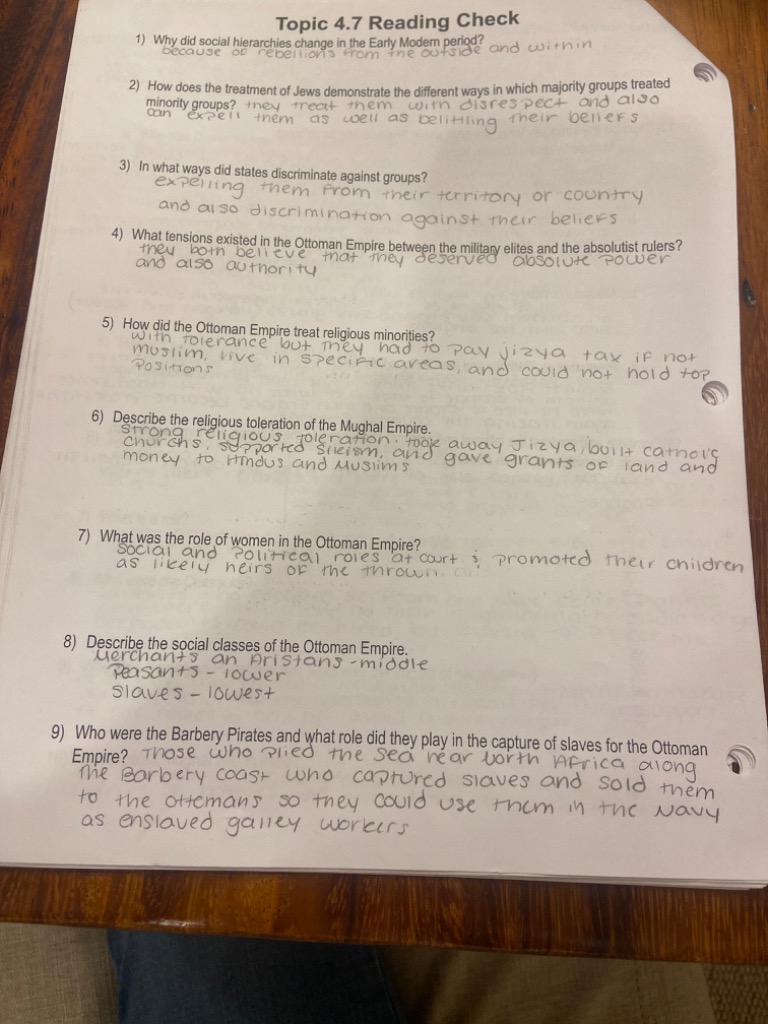
-
Social Hierarchies in the Early Modern Period
- Social hierarchies changed due to external and internal rebellions.
- This indicates a time of social upheaval, where the status quo was challenged by those marginalized or oppressed, leading to shifts in power dynamics.
-
Treatment of Jews as Minority Groups
- Jews were treated with disrespect, subjected to ridicule, and could be expelled.
- This reflects broader societal attitudes towards minority groups and highlights issues of intolerance and discrimination prevalent in that era.
-
Discrimination Against Groups
- Discrimination was exhibited through expulsion and belittlement of beliefs.
- Such treatment underscores the challenges faced by marginalized communities, fostering environments of hostility and division.
-
Tensions in the Ottoman Empire
- Conflicts existed between military elites and absolutist rulers over power and authority.
- This reveals the complexities of governance in the empire, where different factions vied for control, impacting stability and policy-making.
-
Religious Minorities in the Ottoman Empire
- Religious minorities faced taxes (jizya) and restrictions on where they could live.
- This practice illustrates the Ottoman approach to religious diversity, balancing tolerance with economic imposition.
-
Religious Tolerance in the Mughal Empire
- The Mughal Empire displayed varying degrees of tolerance, with some rulers abolishing the jizya and promoting inclusivity among different faiths.
- This indicates a progressive stance that contributed positively to social cohesion.
-
Role of Women in the Ottoman Empire
- Women had significant roles in social and political spheres, especially at court.
- Their influence as potential heirs suggests a more nuanced understanding of gender dynamics during this period.
-
Social Classes of the Ottoman Empire
- Classes:
- Merchants (middle)
- Christians (middle)
- Peasants (lower)
- Slaves (lowest)
- This hierarchical structure demonstrates social stratification and varying degrees of power and privilege within the empire.
- Classes:
-
Barbary Pirates and Their Role
- Barbary Pirates captured slaves along the Barbary coast and sold them to the Ottomans for use in the navy.
- This highlights the interconnectedness of slavery with maritime activities, revealing the exploitation rooted in both piracy and state-sponsored endeavors.
Extended readings:
Historical Notes on Qing China, European Nobility, and Jewish Heritage
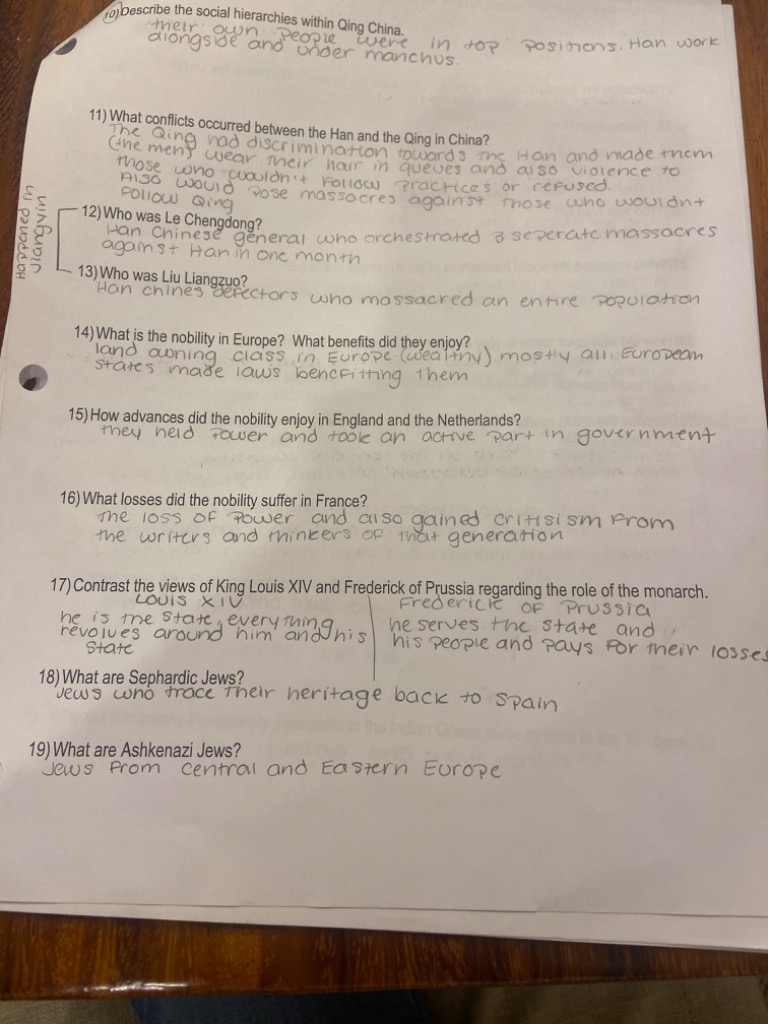
Social Hierarchies in Qing China
- Description: People in top positions were mainly Manchus, while Han people worked alongside and under them.
- Thoughts: This reflects the complex power dynamics during the Qing Dynasty, highlighting ethnic hierarchies and the struggle for power between different groups. The Manchu ruling class enforced their customs and governance styles, which sometimes led to resistance from the Han majority.
Conflicts between the Han and the Qing
- Key Conflicts: Discrimination included forcing Han to cut their hair in queues and violence against those who resisted.
- Thoughts: Such policies illustrate the Qing's efforts to exert control over the Han population, revealing tensions that ultimately contributed to social unrest and resistance, exemplified by the various rebellions throughout Qing rule.
Le Chengdong
- Identity: Han Chinese general known for orchestrating massacres against Han in one month.
- Thoughts: This emphasizes the internal conflicts and betrayals within the Han community during Qing rule, where individuals often turned against their own communities due to political or military motivations.
Liu Liangzuo
- Identity: Han Chinese defector responsible for the massacre of an entire population.
- Thoughts: Liu's actions highlight the tragic consequences of shifting loyalties and the brutal nature of power struggles during this era, contributing to the suffering of civilians.
Nobility in Europe
- Benefits: The land-owning class in Europe enjoyed substantial wealth and influence; the states made laws benefiting them.
- Thoughts: The European nobility's power dynamics played a vital role in governance and social structure, further intensifying class divisions that persisted into modern times.
Nobility in England and the Netherlands
- Advancements: Nobility enjoyed power and took active roles in governing.
- Thoughts: This indicates the significant influence the nobility had on political decisions and framing legislation, shaping the development of modern states.
Losses of Nobility in France
- Impact: The nobility experienced a loss of power and faced criticism from the writers and thinkers of the generation.
- Thoughts: The critique from intellectuals signifies the rise of Enlightenment ideas that challenged the authority of the nobility and the monarchy, paving the way for social and political revolutions.
Louis XIV vs. Frederick of Prussia
| Louis XIV | Frederick of Prussia |
|---|---|
| He considered himself "the state." | He served the state and his people. |
| His leadership centralized power. | Focused on the welfare of the populace. |
- Contrast the Views: Louis XIV embodied absolute monarchy, while Frederick viewed his reign as a duty to his subjects.
- Thoughts: This contrast showcases different philosophies of governance that influenced European political thought and practice, affecting future revolutions and forms of government.
Jewish Heritage
-
Sephardic Jews: Jews tracing their heritage back to Spain.
- Thoughts: The history of Sephardic Jews reflects the broader story of Jewish diaspora and the cultural impacts of expulsion, particularly after 1492.
-
Ashkenazi Jews: Jews originating from Central and Eastern Europe.
- Thoughts: Ashkenazi Jews developed distinct cultural and religious practices influenced by their environments throughout Europe, contributing to the vibrant tapestry of Jewish identity today.
Extended readings:
Notes on Historical Social Structures and Influences
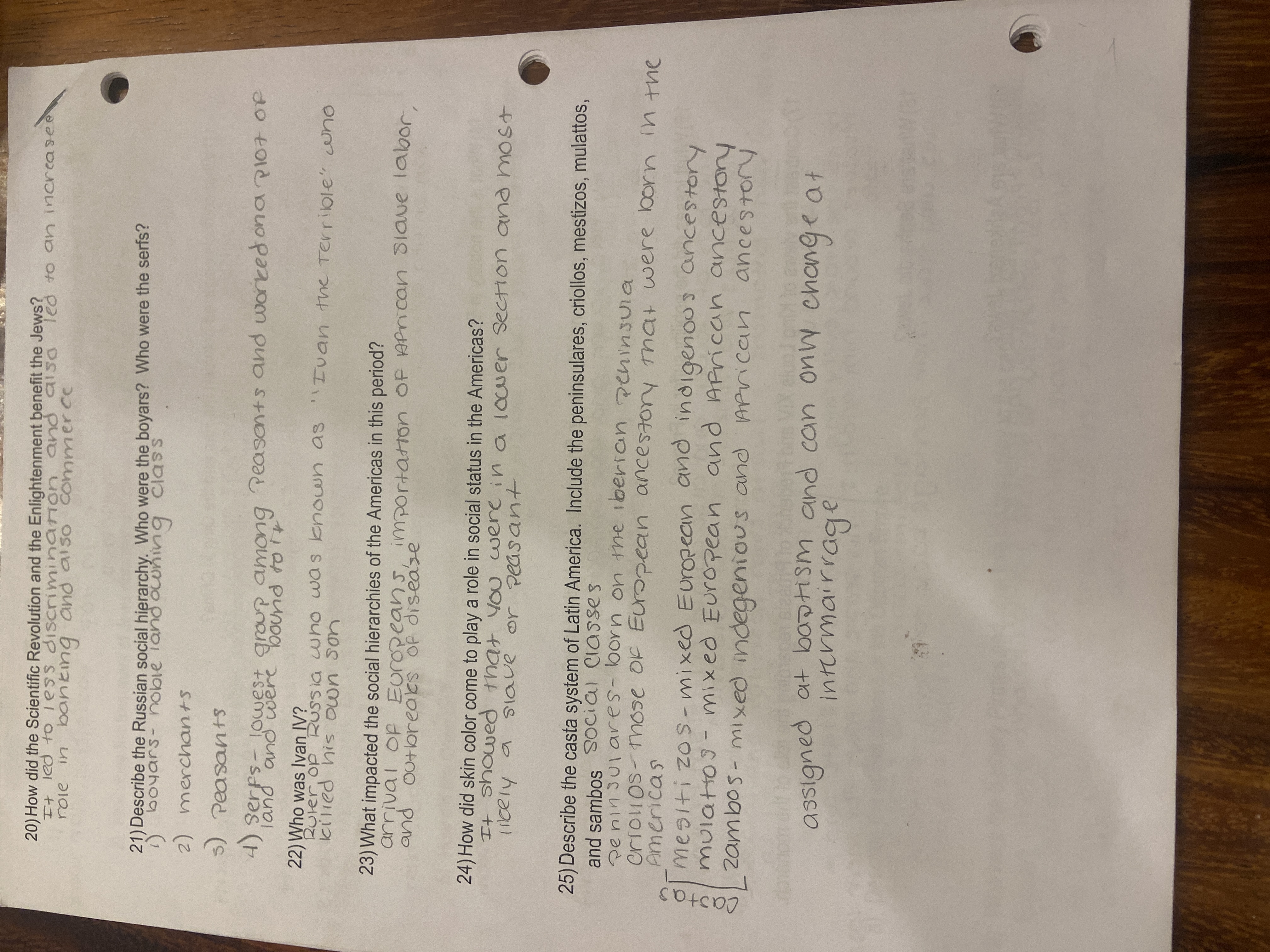
Scientific Revolution and Enlightenment
- Benefit to Jews: Led to less discrimination, increased participation in banking and commerce.
- Thoughts: The Scientific Revolution and Enlightenment emphasized rational thought and individual rights, which caused shifts in societal norms and attitudes towards marginalized groups, including Jews.
Russian Social Hierarchy
- Hierarchy Overview:
- Boyars: Noble landowning class.
- Merchants: Economic class involved in trade.
- Peasants: Worked the land, contributing to the agrarian economy.
- Serfs: Lowest group among peasants, bound to land and labor.
- Thoughts: This hierarchy influenced social mobility and the distribution of wealth in Russia, with privileges tied closely to land ownership and noble status.
Ivan IV (Ivan the Terrible)
- Description: Ruler of Russia known for his autocratic rule and violent tendencies, famously killed his own son.
- Thoughts: Ivan IV's reign exemplifies the complexities of absolute power, illustrating how personal tragedies influenced political decisions and societal stability.
Social Hierarchies in the Americas
- Impact Factors: Arrival of Europeans, importation of African slave labor, and outbreaks of disease.
- Thoughts: The convergence of these factors drastically altered population dynamics and social structures, leading to complex hierarchies based on race and class.
Skin Color and Social Status in the Americas
- Observation: Skin color played a crucial role in determining social status, often relegating individuals to lower sections of society, such as slaves or peasants.
- Thoughts: This reflects broader themes of racial discrimination and social stratification, which were often codified in colonial laws.
Casta System of Latin America
-
Social Categories:
Casta Description Peninsulares Born on the Iberian Peninsula, highest status Criollos Of European ancestry born in the Americas Mestizos Mixed European and Indigenous ancestry Mulattos Mixed European and African ancestry Zambos Mixed Indigenous and African ancestry -
Notes on Casta System:
- The casta system established a rigid social structure based on racial and ethnic lineage.
- Thoughts: This classification had lasting effects on social mobility and the treatment of individuals based on their racial background, which can still be seen in contemporary social issues.
-
Intermarriage: Individuals were often assigned their caste at baptism and could only change through intermarriage.
- Thoughts: This rigid system highlights the challenges of social mobility and the significant impact of race and ethnicity on identity in colonial societies.
Extended readings: